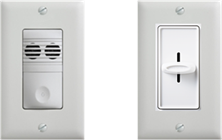
Certification to the Energy Commission is completed by manufacturers of regulated devices. Certification includes a declaration of compliance, executed under penalty of perjury of the laws of California, that the regulated device meets the requirements of the Standards.
A. For compliance with the Title 20 Appliance Efficiency Regulations and the Title 24 Building Energy Efficiency Standards, the Energy Commission maintains a database of appliances, controls, and other devices which have been certified to the Energy Commission.
B. For compliance with the residential lighting Standards, this database includes lighting controls, ballasts for residential recessed luminaires, and high efficacy LED lighting systems.
C. Lighting controls, and ballasts for residential recessed luminaires are two of the devices which shall not be installed unless they have been certified by the manufacturer and listed on this database.
D. LED lighting systems cannot be counted as “high efficacy” for the purposes of code compliance unless that have been certified and listed on the database. The database and certification instructions are available from the following web links:
www.energy.ca.gov/appliances/database/index.html
www.energy.ca.gov/appliances/forms/
Building departments, builders, contractors, and lighting designers should check to database to verify that a regulated device has been certified to the Energy Commission by the manufacturer of that device.
Self-contained lighting controls are required to be certified to the Energy Commission by the manufacturer.
A. A self-contained lighting control is defined as a unitary lighting control module that requires no additional components to be a fully functional lighting control.
B. Self-contained lighting control devices cannot be sold or offered for sale in California unless they have been certified to the Energy Commission according to the Title 20 Appliance Efficiency Regulations.

A. A lighting control system is defined by the Standards as requiring two or more components to be installed in the building to provide all of the functionality required to make up a fully functional and compliant lighting control. Therefore, a lighting control system must functionally meet all applicable requirements in the Standards.
B. Lighting control systems are not required to be certified to the Energy Commission, but are required to comply with the minimum performance requirements in §110.9, and a Certificate of Installation must be signed in accordance with the requirements in §130.4.
1. The minimum performance requirements in §110.9 of the Standards requires that a lighting control system functionally meet all of the requirements that a self-contained lighting control is required to meet. For example, a vacancy sensor system must functionally meet all of the requirements in the Title 20 Appliance Efficiency Regulations for a self-contained vacancy sensor.
2. A single lighting control system that is installed to provide the functionality of more than one lighting control device is required to provide all of the functionality of each respective lighting control for which it is installed.
3. Whenever a lighting control system is installed to comply with lighting control requirements in Title 24, a licensee of record must fill out and sign an Certificate of Installation in accordance with the requirements in §130.4. If the Certificate of Installation is not submitted, the lighting control system shall not be recognized for compliance with the Standards.
C. Specific types of lighting control systems must also meet the following requirements:
1. An Energy Management Control System (EMCS) may be used to comply with dimmer requirements if at a minimum it provides the functionality of a dimmer, and a Certificate of Installation is signed.
2. An Energy Management Control System (EMCS) may be used to comply with vacancy sensor requirements if at a minimum it provides the functionality of a vacancy sensor, and a Certificate of Installation is signed.
3. A multi-scene programmable controller may be used to comply with dimmer requirements if at a minimum it provides the functionality of a dimmer.
4. Lighting controls and equipment are required to be installed in accordance with the manufacturer's instructions.
For a light emitting diode (LED) lighting system to qualify as high efficacy for compliance with the residential lighting Standards, an LED luminaire, or LED light engine shall be certified to the Energy Commission by the manufacturer as meeting all of the following conditions:
1. Shall meet the minimum efficacy requirements in Table 150.0-B (explained in sections 6.3.2 and 6.3.3 of this chapter)The LED lighting system shall be tested by an independent testing lab, according to IES LM-79-08.
For calculating kitchen lighting loads, input power shall be determined as specified by §130.0(c)9 (explained in section 6.4 of this chapter).
See Section 6.3.7; 6.4.6; and 6.9 of this chapter for additional information about residential LED lighting requirements.
All ballasts for compact fluorescent luminaires, when used in residential recessed luminaires, shall be certified by the manufacturer to the Energy Commission according to §110.9(f), as meeting the following conditions:
1. Be rated by the ballast manufacturer to have a minimum rated life of 30,000 hours when operated at or below a specified maximum case temperature. This maximum ballast case temperature specified by the ballast manufacturer shall not be exceeded when tested in accordance to UL 1598 §19.15; and
2. Have a ballast factor of not less than 0.90 for non-dimming ballasts and a ballast factor of not less than 0.85 for dimming ballasts.